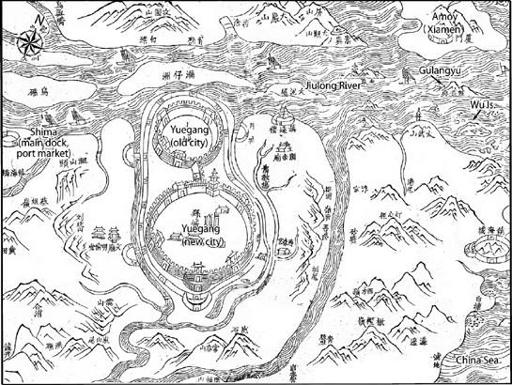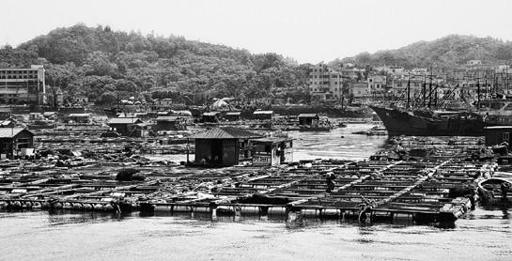1493: Uncovering the New World Columbus Created (22 page)
Read 1493: Uncovering the New World Columbus Created Online
Authors: Charles C. Mann
Tags: #Americas (North; Central; South; West Indies), #Expeditions & Discoveries, #United States, #Colonial Period (1600-1775), #History

Wokou
filled the southeastern coast. Literally,
wokou
means “Japanese pirates,” but most weren’t Japanese and many weren’t pirates. Although they sometimes had bases in Japan, the majority of the
wokou
groups were led by Chinese traders who turned to smuggling after one Ming edict or another eliminated their livelihoods. Their ships were crewed by a crazy quilt of citizens in trouble: scholars who had failed to obtain an official post; bankrupt businesspeople; draft dodgers; fired government clerks; starving farmers; disgraced monks; escaped convicts; and, of course, actual professional smugglers. Scattered among them were a few skilled sailors lured into piracy by the promise of wealth. When officials tried to stop these people, violence often ensued. Every now and then this led to the occupation of a city. “Merchants were pirates, pirates were merchants,” Lin Renchuan, a historian at Xiamen University, told me. They would trade peacefully if they could; not so peacefully if they couldn’t.
China’s efforts to control piracy were hampered by incompetence at the top. Histories of the late Ming dynasty are like advertisements for the virtues of democracy. One emperor refused to meet with his ministers for twenty years. Another was a drunk. A third ran away from his duties and lived in the palace garden, researching alchemical recipes for immortality and prostituting hundreds of young women. This last was the Jiajing emperor, who reigned from 1521 to 1567. He put the empire into the hands of a cabal of grand secretaries, who concerned themselves with personal advancement, rather than, say, the piracy on the southeast coast.

Click
here
to view a larger image.
Worst affected by piracy was the resource-poor province of Fujian, in southeastern China, facing Taiwan across the Taiwan Strait. Most of the province consists of low but craggy mountains with weathered red soil; flat, arable land is mainly confined to river valleys and a narrow ribbon along the coast. “The mountains peak in rocky summits, and the labor of plowing never ceases,” moaned one thirteenth-century Fujianese writer. “The lowlands are salt marshes and cannot be tilled.” Famine was a constant risk; despite big terracing and land-reclamation projects, Fujian couldn’t grow enough grain to feed itself. Half of the province’s rice had to be imported—not an easy task, because the mountains isolate Fujian from the rest of the nation. Among the region’s few natural assets are the fine natural harbors that scallop its stony coast. For evident reasons, Fujian depended on the sea. It has long been China’s center for maritime trade—which, in the days of sail, meant that it was China’s center for international trade. When international trade was officially banned, Fujianese found themselves in an uncomfortable position—there was nothing for them on land.

The walled city of Yuegang, portrayed in this seventeenth-century Chinese map, was once one of the world’s most important ports. Today its role has been taken by the modern city of Xiamen (then the village of Amoy), on an island in the harbor. (
Photo credit 4.2
)
Click
here
to view a larger image.
The conflict was particularly intense around the port city of Yuegang. Located at the mouth of the Jiulong River, Yuegang’s harbor was full of small islets, sandbars, and other shipping hazards. Because of the area’s notorious haze, navigation was difficult—when I puttered about the harbor during my visits, I sometimes couldn’t see boats that were only a few hundred yards away. The main docks were several miles up the Jiulong, in water so shallow that ships had to be towed in on the incoming tide. The location was an anti-piracy measure: criminals would not dare raid the docks, because the incoming tide that permitted entrance was too strong to allow escape. At the same time, many Yuegang shipowners
were
pirates—the harbor protected them from people like themselves.
The old city, full of Tang dynasty shrines, was connected by a raised walkway to the newer Ming city, built further inland with larger walls. Inside both were packed huddles of houses—“bandit dens,” sneered one official in the 1560s, whose inhabitants “have collaborated with foreigners to spread chaos to the detriment of the local area for a long time now.” Indeed, Yuegang was such a pirates’ paradise that at one point Beijing divided the populace into groups of ten families that had to account for their members every five days; if one family did something illegal, all ten would be punished.
Imperial China’s day-to-day history is largely recorded in the annual gazetteers sent to Beijing from each of the nation’s counties. Yuegang’s county had so much
wokou
trouble that the gazetteer’s compilers eventually devoted a special appendix to it: “Bandit Incursions.”
Bandit Incursions began in 1547, when a Dutch merchant/pirate/smuggler group set up a base on Wu Island, a recently shuttered naval base just south of Yuegang’s harbor. “Dutch” is a bit of a misnomer; the traders flew a Dutch flag, but they were a hodgepodge of Spanish, Portuguese, and Dutch hustlers with some semi-enslaved Malays. Chinese and Japanese
wokou
happily sent ships to trade with them, as did legitimate businesspeople from Yuegang; a busy, multilingual market sprang up in Wu Island’s small but serviceable harbor. Unenthusiastic about the encampment was Zhu Wan, governor for both Fujian and Zhejiang, the province to the north. He dispatched soldiers to drive out the foreigners.
Wu Island consists of two rocky, steep, scrub-covered mounds with a low “saddle” between them. The Dutch had ensconced themselves in an improvised fort atop one of the mounds, forcing the Chinese to attack uphill. In a brief skirmish, the merchant/pirate group beat back the Chinese forces. Zhu changed tactics: he imprisoned ninety local merchants who had traded at Wu Island. In a gesture that even the unsympathetic gazetteer described as altruistic, the Dutch sent emissaries to plead for their allies’ lives. Dismissing the entreaties, Governor Zhu beheaded all ninety. The Dutch abandoned Wu Island and gave up their attempt to trade openly; later they roamed the region, preying on the very Fujianese merchants and smugglers with whom they previously had collaborated.

A former pirate stronghold, Wu Island, in the hazy waters off of Yuegang, is now a center for fishing and aquaculture. (
Photo credit 4.8
)
Zhu Wan was anything but satisfied. A rigid, moralistic former magistrate, Zhu irritated his superiors by denouncing corruption at every level in a spray of angry memoranda. He was such a stickler that when his subordinates gave small gifts to his visiting family he punished himself with a hefty fine. Late in 1548 Zhu assaulted a major smuggling base in Zhejiang, scuttling more than 1,200 illicit boats. Led by the infamous “Baldy” Li,
wokou
fled by the hundred to a new base in the extreme southern end of Fujian. Three months later Zhu’s men hunted them down there, killing almost 150 and capturing scores of Portuguese, Japanese, and Chinese smugglers.
Many of Li’s gang turned out to be from influential Yuegang merchant families.
3
Angered by this evidence of routine collusion among local elites and foreign smugglers, Zhu ordered all the captives to be summarily executed—the second round of executions in two years. The executions united Zhu’s enemies against him. Yuegang’s wealthy appealed to Zhu’s superiors: the courtiers of the alchemy-besotted Jiajing emperor. Zhu was demoted, then fired, then subjected to politically motivated investigations. Facing indictment, he poisoned himself in January 1550. “Even if the Emperor doesn’t kill me,” Zhu said, “powerful court officials will kill me. And even if powerful court officials don’t kill me, the people of Fujian and Zhejiang will kill me.”
Emboldened by Zhu’s absence, pirate gangs seized entire towns, pillaging “until the stench of rotten flesh forced them to leave.” In one city north of Yuegang more than twenty thousand people died after a pirate assault. Across southeast China, the Ming historian Luo Yuejiong recalled, terrified families “ate without cooking their food, and slept unsoundly on their pillows; farmers left behind their pitchforks and women dozed off on their looms.” When the
wokou
attacked, Luo wrote,
fathers and sons, young and old, were taken prisoner and followed the pirates on the road. As for the dead, their heads and bodies were found in different places, bones left out in the grassy swamps, heads stiff. Looking on the horizon, the coastal counties were almost nothing but hilly ruins.
Wokou
were “ burning homes, seizing women and children, and stealing huge quantities of valuables,” wrote the chronicler Zhuge Yuansheng in 1556. “Officials and common people alike were killed with weapons, their bodies, numbering in the tens of millions [an idiom for “huge numbers”], filled ravines. Government troops dared not oppose them.” At the mere appearance of
wokou
in an area, he wrote, “people scream in panic and take flight.” In a scene straight out of a Stephen Chow martial-arts comedy,
[a] messenger from Songjiang [near Shanghai] rode at a gallop into town and cried out to his followers, “We’re here! we’re here!” The locals misunderstood him and thought the [pirates] were coming. Men and women scurried like ants, nothing could stop them. Women and children were separated, families lost countless valuables and possessions. At the time, more than 600 soldiers were garrisoned at the city, stationed on the bastions along the walls; they all threw down their weapons and armor and ran away. Not until the next day did calm return to the town.
In Yuegang the
wokou
didn’t strike back at the government until 1557, according to the county gazetteer, when a disgruntled farmer secretly opened the city gates to two pirate gangs. Overwhelming all resistance, the
wokou
“abducted more than a thousand people and burned more than a thousand homes.”
Dire as it was, the assault was a sideshow. Even as
wokou
beset Yuegang, twenty-four of the city’s merchants pooled resources and built a fleet to work with the pirates in what amounted to an interlocking network of joint ventures. The traders had access to domestic markets; the smugglers, to foreign goods. Known as the Twenty-four Generals, the merchants decided to control access to their home markets by carving up Yuegang, gangland style, into neighborhoods, each dominated by a single “general” in an earthen-walled fortress. Three hundred imperial soldiers were sent to dislodge them. The Twenty-four Generals beat back the attack. Observing this success, other smugglers in other parts of Fujian followed the Generals’ lead, forming the Twenty-four Constellations and the Thirty-six Bravos. The region became a bewildering, violent amalgam of overlapping loyalties and betrayals, as business gangs and pirate gangs from different neighborhoods, regions, and nations vied among themselves for control of the smuggling trade.
